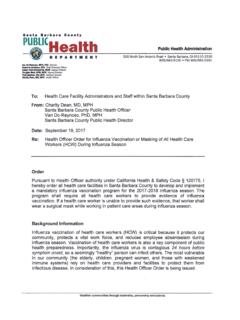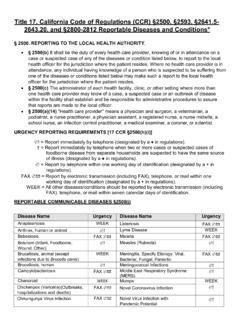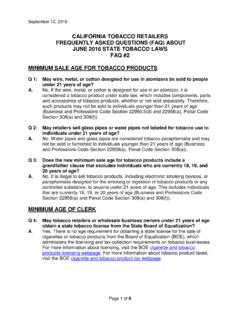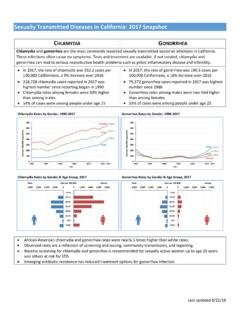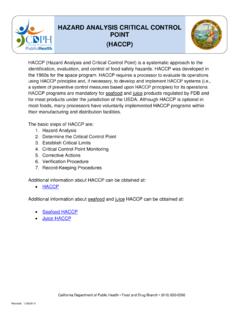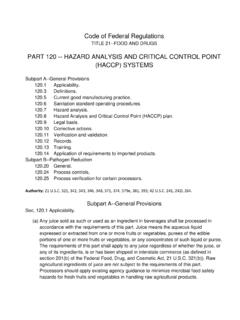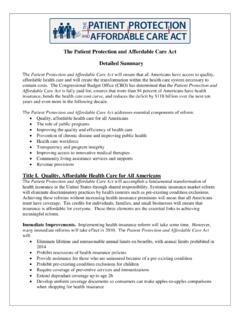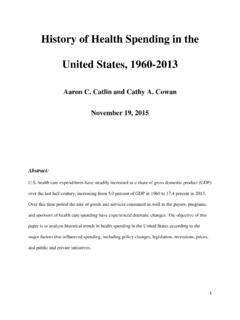Transcription of Prescribing Guidelines Comparison - CDPH Home
1 INTRODUCTION TO Prescribing Guidelines Comparison Attached is a Comparison between the Centers for Disease Control and Prevention s Guidelines for Prescribing Opioids for Chronic Pain and the Medical Board of California s Guidelines for Prescribing Controlled Substances for Pain. While there are a few differences between these two prescriber Guidelines , overall there are many more similarities demonstrating how each complements the other and together can be effective educational tools for prescribers. Differences between the two Guidelines are not due to contradicting opinions/recommendations, but rather to the intended use and audience for each.
2 BACKGROUND The Medical Board of California (MBC) is a state regulatory agency whose mission is to protect health care consumers through the proper licensing and regulation of physicians and surgeons and certain allied health care professions and through the vigorous, objective enforcement of the Medical Practice Act, and to promote access to quality medical care through the Board's licensing and regulatory functions. The MBC is the only entity who can take disciplinary action against a California physician s license. In Prescribing cases, the MBC takes action based upon the standard of care that a physician provides to a specific patient. The Centers for Disease Control and Prevention (CDC) is a federal agency that conducts and supports health promotion, prevention and preparedness activities in the United States with the goal of improving overall public health.
3 As the nation s health protection agency, CDC s mission is to save lives and protect people from health threats. CDC s primary role is tackling the biggest health problems causing death and disability for Americans, including reducing deaths due to prescription painkiller abuse and overdose. INTENDED USE The MBC Guidelines are intended for all physicians practicing in California. They provide a broader range of recommendations for explicit patient populations in specific settings. The MBC Guidelines were designed to educate physicians for improved outcomes of patient care and to prevent overdose deaths due to opioid use. Since the MBC Guidelines primary goal was to educate physicians, and are based upon the enforcement role of the MBC, the MBC Guidelines do not have the specificity that the CDC Guidelines contain.
4 The CDC Prescribing Guidelines were developed to address the opioid epidemic currently sweeping across the United States. The CDC Guidelines are intended for primary care physicians to provide recommendations for the Prescribing of opioid pain medication for patients 18 and older in primary care settings. Recommendations focus on the use of opioids in treating chronic pain (pain lasting longer than 3 months or past the time of normal tissue healing) outside of active cancer treatment, palliative care, and end-of -life care. PRIMARY DIFFERENCES 1. The MBC Guidelines recommend referral to pain specialists while the CDC Guidelines encourage Primary Care Physicians (PCP) to work with their patients to manage pain. 2. The MBC endorses up to 45 days for initiating opioid trial, with the explanation that after 90 days there is risk.
5 The CDC notes after seven (7) days there is risk with Prescribing opioids. 3. The CDC recommends taking precaution when increasing from 50 morphine milligram equivalents (MMEs) per day and to avoid increasing past 90 MMEs per day. The MBC recommends a physician proceed cautiously once 80 MMEs per day is reached. CDC and MBC PRESCRIBER Guidelines OVERALL OBJECTIVES Improving the way opioids are prescribed through clinical practice Guidelines can ensure patients have access to safer, more effective chronic pain treatment while reducing the number of people who misuse, abuse, or overdose from these drugs. Prescribers should be encouraged to use both Guidelines to educate themselves on appropriate Prescribing practices. nd Strategy PlanIntended Use of Prescriber Guidelines and Strategy PlanDETERMINING WHEN TO INITIATE or CONTINUE OPIOIDS for CHRONIC PAINCOMPARISON OF Prescribing Guidelines FOR CONTROLLED SUBSTANCES (OPIOIDS) FOR CHRONIC PAIN Centers for Disease Control and Prevention (CDC) Prescriber Guidelines for Chronic Pain Background/Reason for Prescriber Guidelines aCDC recommendations are based upon the following assessment.
6 No evidence of long-term benefit from opioids in pain and function for chronic pain with outcomes examined at least 1 year later; Extensive evidence shows the possible harms of opioids (including abuse and dependence, overdose, myocardial infarction, motor vehicle crashes); and Extensive evidence suggests benefits of alternative treatments compared with long-term opioid therapy, including non-pharmacologic therapy and non-opioid pharmacologic therapy, with less harm. These Guidelines are intended for primary care physicians who are treating patients with chronic pain ( , pain lasting longer than three months or past the time of normal tissue healing) in outpatient settings. The recommendations are not intended: a) for guidance on use of opioids as part of medication-assisted treatment for opioid use disorder; b) for patients who are in active cancer treatment, palliative care, or end-of-life care.
7 The three sections/categories below are based upon CDC recommendations. Non-pharmacologic therapy and non-opioid pharmacologic therapy preferred for chronic pain Before starting opioid therapy for pain, providers should establish treatment goals with all patients, including realistic goals for pain and function Providers should not initiate opioid therapy without consideration of how therapy will be discontinued if unsuccessful Providers should continue opioid therapy only if there is clinically meaningful improvement in pain and function that outweighs risks to patient safety Medical Board of California (MBC) Prescriber Guidelines for Substances for Pain MBC s Guidelines are intended to improve outcomes of patient care and to prevent overdose deaths due to opioid use.
8 They particularly address the use of opioids in the long-term treatment of chronic pain. MBC recommendations are based upon: Special patient populations including: Emergency Departments, Urgent Care Clinics, Acute Pain, End-of-Life Pain, Cancer Pain, Older Adults, Pediatric Patients, Pregnant Women, Patients Covered by Workers Compensation, Patients with History of Use Disorder, Psychiatric Patients, Patients Prescribed Benzodiazepines and Patients Prescribed Methadone or Buprenorphine for Treatment of a Substance Use Disorder. These Guidelines are intended for all physicians practicing in California. These Guidelines are not meant for the treatment of patients in hospice or palliative care settings or to limit treatment where improved function is not anticipated and pain relief is the primary goal.
9 Emergency Departments (ED) or Urgent Care Clinics Physicians should avoid the routine Prescribing of outpatient opioids for a patient with an acute exacerbation of chronic non-cancer pain seen in the ED If opioids are prescribed on discharge, the prescription should be for the lowest practical dose for a limited duration ( , < 1 week). The prescriber should consider the patient s risk for opioid misuse, abuse, or diversion The physician should, if practicable, honor existing patient-physician pain contracts/treatment agreements and consider past prescription patterns from information sources such as prescription drug monitoring programs Comparison of Prescribing Guidelines Indicates differences between the Guidelines Page 1 Comparison OF Prescribing Guidelines FOR CONTROLLED SUBSTANCES (OPIOIDS) FOR CHRONIC PAIN Centers for Disease Control and Prevention (CDC)
10 Prescriber Guidelines for Chronic Pain Before starting and periodically during opioid therapy, providers should discuss with patients known risks and realistic benefits Discuss patient and provider responsibilities for managing therapy When starting opioid therapy for chronic pain, providers should prescribe immediate-release opioids instead of extended-release/long-acting (ER/LA) opioids When opioids are started, providers should prescribe the lowest effective dosage Providers should use caution when Prescribing opioids at any dosage, should implement additional precautions when increasing dosage to 50 morphine milligram equivalents (MMEs)/day, and should generally avoid increasing dosage to 90 MME/day When opioids are used for acute pain, providers should prescribe the lowest effective dose of immediate-release opioids and should prescribe no greater quantity than needed for the expected duration of pain severe enough to require opioids Three of fewer days usually will be sufficient for most non-traumatic pain not related to major surgery Providers should evaluate benefits and harms with patients within 1 to 4 weeks of starting opioid therapy for chronic pain or of dose escalation Providers should evaluate benefits and harms of continued therapy with patients every 3 months or more frequently Medical Board of California (MBC)
